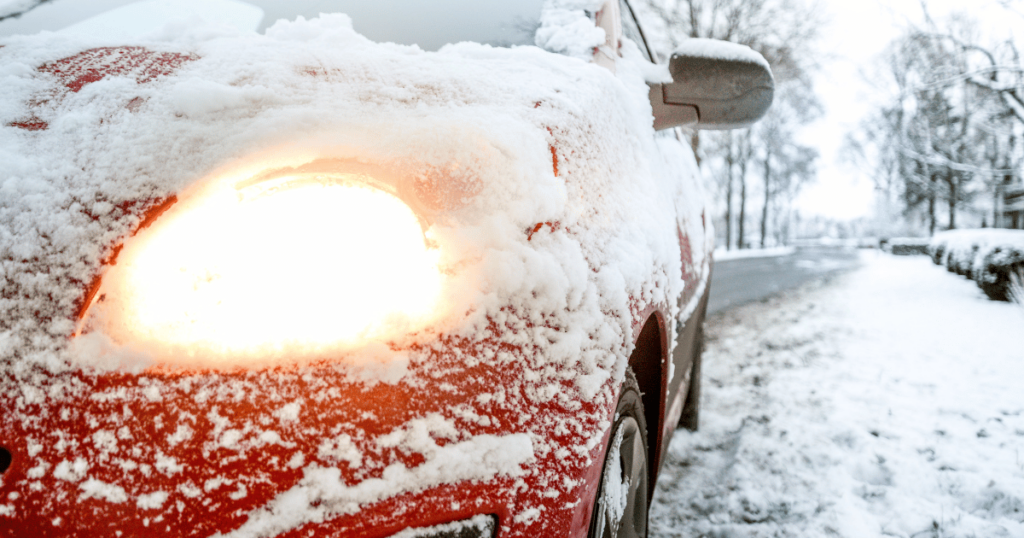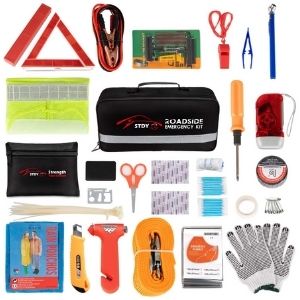Winter driving can be dangerous due to wet and icy roads. You can make things safer by making sure your vehicle is up to the challenge. Experts at CarParts.com gave us these seven maintenance tips for making sure you're ready to hit the road.
Make Winter Driving Safer with These 7 Maintenance Tips
For over 11 years, SafeWise experts have conducted independent research and testing to write unbiased, human reviews (not robots). Learn more.
Sign up for our free weekly newsletter to get the best safety news, product info, and deals.
By signing up, you agree to our Terms and Conditions and Privacy Policy.

Image: Skitterphoto, Pexels
1. Ensure your tires are rated for cold/snow
In cold and snowy conditions, using winter tires designed for low temperatures and icy/snowy surfaces is critical. Tires rated for these conditions are marked on the sidewall with an “M+S” or 3 peak mountain and snowflake. These tires have special rubber compounds that remain flexible in cold weather, providing better traction.
The right tires aren't everything. Staying up to date with routine and preventative tire maintenance is key and can help reduce the risk of accidents. Tire chains are also essential for driving in extremely snowy or icy conditions, as they provide additional traction, which improves vehicle control. Check local regulations, as some areas may require or prohibit the use of tire chains.
For more, read our article: Do You Have the Right Tires for Winter Weather? Maybe Not.
2. Check your coolant/anti-freeze level
Ensure the coolant is a proper mixture of antifreeze and water to prevent freezing, and consider a coolant flush if it hasn't been done recently to remove any contaminants. Confirming the ratio of anti-freeze to water is an important step to avoid breaking down in areas with limited visibility, putting all vehicles on the road at risk.
3. Check your battery and have it tested
Battery replacement is the most common car repair during cold weather. As temperatures drop, batteries can fail or lose charge, leading to longer crank times or a vehicle not starting at all.
Be prepared to replace your car battery every 3 to 5 years, especially in places with longer and colder winter months. Over time, batteries degrade and performance decreases. If you live in an area with harsh winters, it’s important to routinely monitor your battery's health to determine when a replacement is needed.
Additionally, cleaning the battery terminals helps ensure a good connection.
4. Always be prepared with your emergency kit
Few drivers are properly equipped with emergency tools if their car experiences an issue. Items every driver should keep on them at all times are:
- Battery jump start pack/jumper cables: Cold temperatures can be tough on car batteries, leading to reduced efficiency or potential failure. A jump start pack or charger can help restart your vehicle without needing another vehicle for a jump start.
- Tire compressor and patch kit: In the event your tire is losing pressure, having a small compressor can help you get back on the road long enough for you to get to a tire shop for a stronger repair or a new tire.
- Snacks/water: If your car breaks down, having snacks and water will keep your body fueled long enough until help arrives, especially if you have broken down late at night.
- Traffic triangle: This helps other cars see you during low visibility.
- Basic tools: Having the basic tools and maybe a YouTube video could get you out of a rough situation and back home.
*Amazon.com price as of post date. Offers and availability may vary by location and are subject to change. Read full disclaimer.
5. Check your brakes
Ice, snow, and other winter hazards make hydroplaning and skidding more common. As a result, it’s crucial for the safety of all vehicles on the road that a car’s brakes and anti-lock braking system (ABS) are ready to perform at their peak:
- Check brake pads, rotors, and brake fluid.
- Be sure to replace worn brake pads and ensure the brake system is in good condition for reliable stopping power.
- Be on the lookout for an ABS light on the dashboard and if your ABS light is on, consider replacing the vehicle speed sensors or ABS module.
6. Inspect your lights
Functioning lights are important to increase visibility as inclement weather makes it harder for drivers to see obstacles like ice or fallen trees, in addition to oncoming traffic. Ensure all exterior lights are working correctly, especially in places with unpredictable weather patterns and fewer daytime hours in the winter months. This includes headlights, brake lights, turn signals, and emergency flashers. Taillights are just as important as headlights in winter months when visibility is poor. Making sure other drivers see you is just as important as seeing them.
Recent Articles




